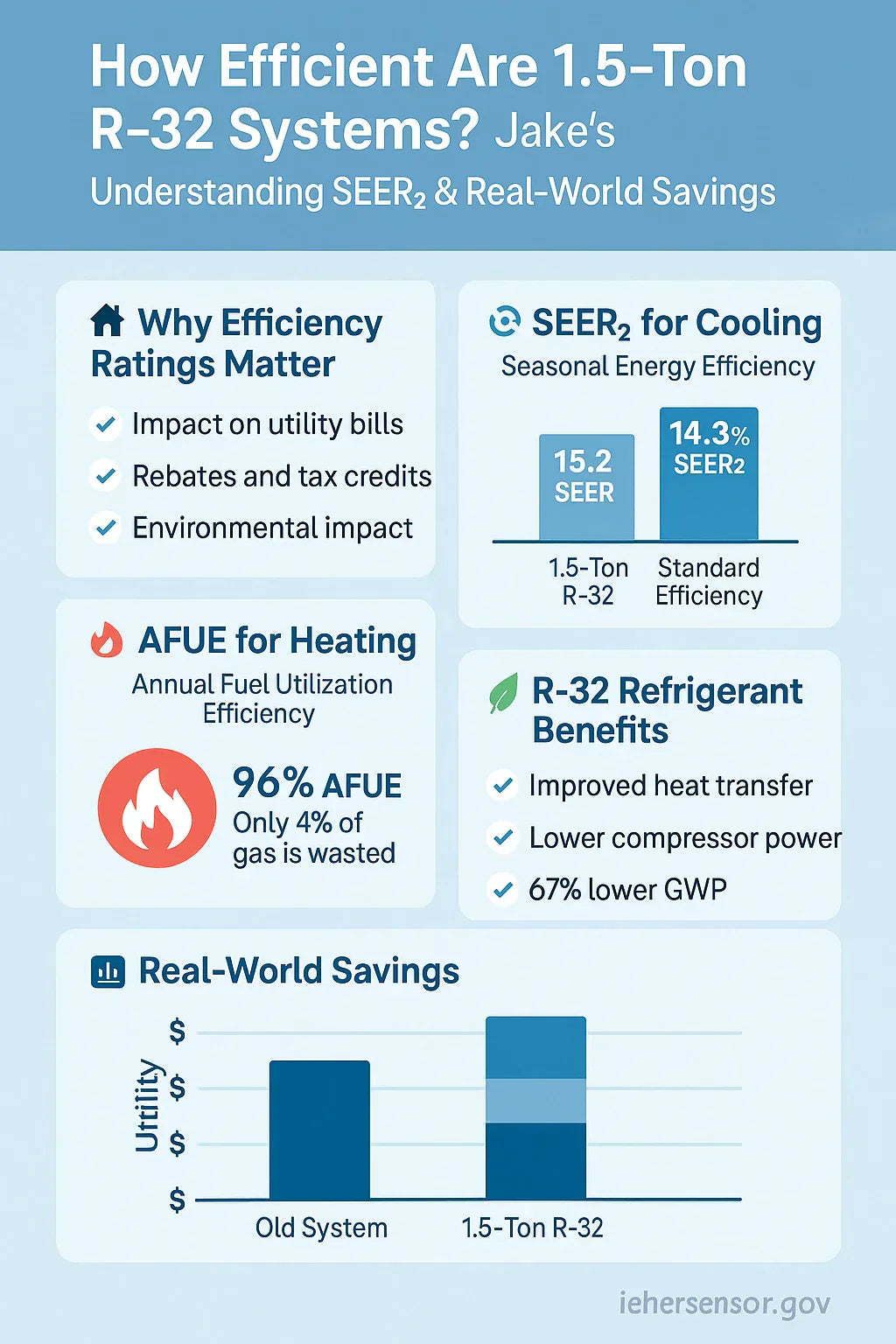🏠 Why Efficiency Ratings Matter
When I started looking at 1.5-ton R-32 AC and gas furnace combos, my first thought was: Will it keep me comfortable?
My second thought: How much will it cost to run?
Efficiency ratings aren’t just marketing numbers. They directly influence:
-
Your monthly utility bill
-
Whether you qualify for energy rebates or tax credits
-
The environmental impact of your HVAC system
📎 ENERGY STAR — Why Efficiency Matters
Best 1.5 Ton AC and Gas Furnaces
For me, efficiency was a balancing act — higher efficiency usually means a higher upfront cost, but it can pay off in the long run.
📊 What SEER2 Means for Your AC
📏 The Old SEER vs. the New SEER2
SEER (Seasonal Energy Efficiency Ratio) used to be the standard. But as of January 1, 2023, the U.S. moved to SEER2, which:
-
Uses more realistic external static pressure in testing (0.5 in. w.c. vs. 0.1–0.3 for SEER)
-
Better reflects real-world ductwork conditions
-
Typically results in a ~4.7% lower number compared to the old SEER
📎 DOE — SEER2 Testing Standards
🌡 Typical SEER2 for 1.5-Ton R-32 Units
Most 1.5-ton R-32 split AC systems fall between:
-
14.3–15.2 SEER2 for standard single-stage units
-
15.5–17 SEER2 for two-stage or variable-speed units
My system is a 15.2 SEER2 single-stage — solid for my moderate climate.
💡 What SEER2 Means in Dollars
A 15.2 SEER2 unit uses roughly:
-
~7% less electricity than a 14.3 SEER2 unit
-
Savings in my area: about $30–$45/year in cooling costs
🔥 AFUE for Gas Furnaces
📏 What AFUE Measures
AFUE (Annual Fuel Utilization Efficiency) tells you how much of your gas actually becomes usable heat:
-
80% AFUE: 80¢ of every dollar heats your home, 20¢ is lost
-
95% AFUE: 95¢ heats your home, only 5¢ is wasted
📎 Energy.gov — AFUE Ratings Explained
🏠 Typical AFUE for Small Furnaces
For 40k–60k BTU models that pair with 1.5-ton ACs:
-
80–83% AFUE: Mid-efficiency, lower cost
-
92–98% AFUE: High-efficiency, uses secondary heat exchanger
My furnace is 96% AFUE — meaning in theory, I’m only “wasting” 4% of my fuel.
🌱 R-32’s Role in Efficiency
💨 Better Heat Transfer
R-32 has a higher heat transfer coefficient than R-410A, meaning:
-
The coil can absorb and release heat more effectively
-
The compressor can do less work for the same cooling output
⚡ Lower Compressor Power
In many tests, R-32 units show 3–6% lower energy consumption at the same cooling capacity compared to R-410A.
🌍 Environmental Impact
-
R-32 GWP: ~675
-
R-410A GWP: ~2,088
That’s ~67% lower, helping meet new refrigerant regulations.
📎 Daikin — R-32 Efficiency & GWP Info
📉 Lab Ratings vs. Real-World Savings
Here’s the truth — your actual savings will almost never match the lab numbers.
Why? Because lab testing happens under ideal conditions:
-
Perfect ductwork
-
No filter dirt buildup
-
Outdoor temps within a set range
Jake’s Real Numbers
Before my upgrade:
-
Old system: 13 SEER, 80% AFUE, R-410A
-
Annual energy cost: ~$1,320 ($520 cooling, $800 heating)
After:
-
New system: 15.2 SEER2, 96% AFUE, R-32
-
Annual cost: ~$1,110 ($470 cooling, $640 heating)
Savings: ~$210/year
📎 ACEEE — Real-World vs. Rated Efficiency
⚡ Factors That Can Hurt Efficiency
🚫 Poor Installation
Even the highest SEER2 system will underperform if:
-
Ducts are undersized or leaky
-
Refrigerant charge is off
-
Airflow is restricted
🧽 Dirty Coils & Filters
Reduced airflow = reduced efficiency. A dirty filter can increase energy use by 5–15%.
📏 Wrong System Size
-
Oversized: Short cycles, poor humidity control
-
Undersized: Runs constantly, wearing out components
📎 ENERGY STAR — Proper HVAC Sizing
💰 ROI & Payback Timeline
Upfront Cost Difference
For 1.5-ton systems in 2025:
-
Mid-efficiency: $7,000–$8,500 installed
-
High-efficiency: $8,500–$10,500 installed
Annual Savings
-
Mild climate: $100–$150/year
-
Moderate climate: $150–$250/year
-
Extreme climate: $250–$400/year
Payback
In my moderate climate, my ROI is ~6–8 years — faster if energy prices rise.
🛠 How to Maximize Efficiency
🧼 Keep It Clean
-
Change filters every 1–3 months
-
Wash outdoor coil once a year
-
Vacuum furnace blower annually
📡 Smart Thermostat
-
Use adaptive recovery to avoid big temp swings
-
Program away settings to cut run time
🔒 Seal Ducts
Up to 30% of conditioned air can leak out of ducts in older homes.
🏠 Improve Insulation
Even the most efficient HVAC system will waste energy in a poorly insulated home.
✅ Jake’s Final Efficiency Takeaways
After a full year of running my 1.5-ton R-32 system:
-
My summer bills dropped by about 10%
-
My winter gas use dropped by about 20%
-
The comfort upgrade — more even temperatures, less humidity — was worth it even without the savings
For me, the 96% AFUE furnace made the biggest difference because heating is my largest annual energy expense. The R-32 AC chipped in modest but noticeable savings.
In the next topic we will know more about: Cold Climate Performance: Can a 1.5-Ton R-32 AC and Gas Furnace Keep Jake’s House Warm?







